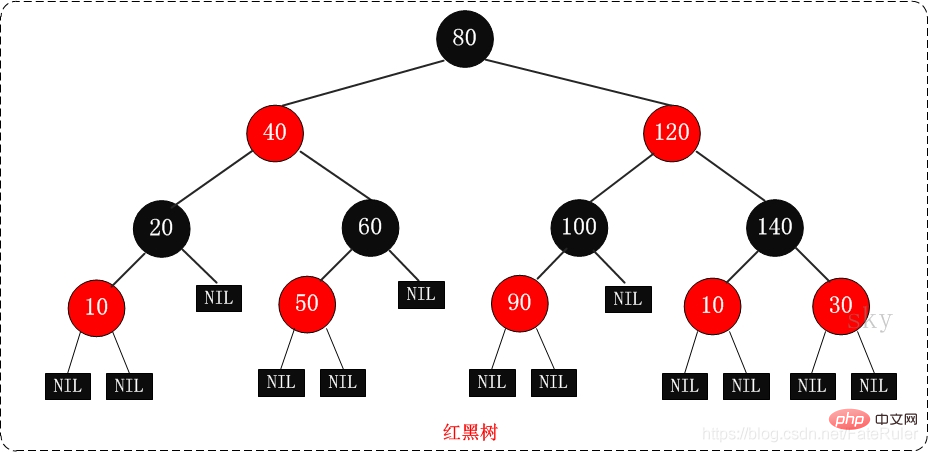java interview-red-black tree

First of all, let’s take a look at the structure of the red-black tree, as shown in the figure:
(Learning video sharing: java teaching video)

The structural characteristics of the red-black tree:
(1) Each node is either black or red.
(2) The root node is black.
(3) Each leaf node (NIL) is black. [Note: The leaf node here refers to the leaf node that is empty (NIL or NULL)! ]
(4) If a node is red, its child nodes must be black.
(5) All paths from a node to the node’s descendant nodes contain the same number of black nodes.
Why use red-black trees?
1. First of all, red-black trees do not meet the balance conditions of AVL trees, that is, binary search trees in which the heights of the left subtree and right subtree of each node differ by at most 1. However, it is proposed to add colors to nodes. Red-black trees use non-strict balance to reduce the number of rotations when adding or deleting nodes. Any imbalance will be resolved within three rotations, while AVL is a strictly balanced tree, so when adding or deleting nodes, When it comes to nodes, depending on the situation, the number of rotations is more than that of the red-black tree. Therefore, the insertion efficiency of red-black trees is higher
(Recommendations for more related interview questions:java interview questions and answers)
2. Red-black trees can perform O( Log2 (n)) time complexity for search, insertion, and deletion operations
3. Simply put, the red-black tree is to solve the shortcomings of the binary search tree, because the binary search tree in some cases will degenerate into a linear structure.
Comparison and selection of red-black tree and balanced tree
1. The balanced tree structure is more intuitive, and the reading performance is higher than that of the red-black tree; the performance of adding and deleting nodes to restore balance is not as good as that of the red-black tree. Black tree
2. The reading performance of red-black tree is not as good as that of balanced tree; the performance of adding and deleting nodes to restore balance is worse than balanced tree
Usage scenarios of red-black tree:
TreeMap, Both TreeSet and HashMap after JDK1.8 use red-black trees at the bottom layer.
Related recommendations: java introductory tutorial
The above is the detailed content of java interview-red-black tree. For more information, please follow other related articles on the PHP Chinese website!

Hot AI Tools

Undresser.AI Undress
AI-powered app for creating realistic nude photos

AI Clothes Remover
Online AI tool for removing clothes from photos.

Undress AI Tool
Undress images for free

Clothoff.io
AI clothes remover

Video Face Swap
Swap faces in any video effortlessly with our completely free AI face swap tool!

Hot Article

Hot Tools

Notepad++7.3.1
Easy-to-use and free code editor

SublimeText3 Chinese version
Chinese version, very easy to use

Zend Studio 13.0.1
Powerful PHP integrated development environment

Dreamweaver CS6
Visual web development tools

SublimeText3 Mac version
God-level code editing software (SublimeText3)

Hot Topics
 1387
1387
 52
52
 Perfect Number in Java
Aug 30, 2024 pm 04:28 PM
Perfect Number in Java
Aug 30, 2024 pm 04:28 PM
Guide to Perfect Number in Java. Here we discuss the Definition, How to check Perfect number in Java?, examples with code implementation.
 Weka in Java
Aug 30, 2024 pm 04:28 PM
Weka in Java
Aug 30, 2024 pm 04:28 PM
Guide to Weka in Java. Here we discuss the Introduction, how to use weka java, the type of platform, and advantages with examples.
 Smith Number in Java
Aug 30, 2024 pm 04:28 PM
Smith Number in Java
Aug 30, 2024 pm 04:28 PM
Guide to Smith Number in Java. Here we discuss the Definition, How to check smith number in Java? example with code implementation.
 Java Spring Interview Questions
Aug 30, 2024 pm 04:29 PM
Java Spring Interview Questions
Aug 30, 2024 pm 04:29 PM
In this article, we have kept the most asked Java Spring Interview Questions with their detailed answers. So that you can crack the interview.
 Break or return from Java 8 stream forEach?
Feb 07, 2025 pm 12:09 PM
Break or return from Java 8 stream forEach?
Feb 07, 2025 pm 12:09 PM
Java 8 introduces the Stream API, providing a powerful and expressive way to process data collections. However, a common question when using Stream is: How to break or return from a forEach operation? Traditional loops allow for early interruption or return, but Stream's forEach method does not directly support this method. This article will explain the reasons and explore alternative methods for implementing premature termination in Stream processing systems. Further reading: Java Stream API improvements Understand Stream forEach The forEach method is a terminal operation that performs one operation on each element in the Stream. Its design intention is
 TimeStamp to Date in Java
Aug 30, 2024 pm 04:28 PM
TimeStamp to Date in Java
Aug 30, 2024 pm 04:28 PM
Guide to TimeStamp to Date in Java. Here we also discuss the introduction and how to convert timestamp to date in java along with examples.
 Java Program to Find the Volume of Capsule
Feb 07, 2025 am 11:37 AM
Java Program to Find the Volume of Capsule
Feb 07, 2025 am 11:37 AM
Capsules are three-dimensional geometric figures, composed of a cylinder and a hemisphere at both ends. The volume of the capsule can be calculated by adding the volume of the cylinder and the volume of the hemisphere at both ends. This tutorial will discuss how to calculate the volume of a given capsule in Java using different methods. Capsule volume formula The formula for capsule volume is as follows: Capsule volume = Cylindrical volume Volume Two hemisphere volume in, r: The radius of the hemisphere. h: The height of the cylinder (excluding the hemisphere). Example 1 enter Radius = 5 units Height = 10 units Output Volume = 1570.8 cubic units explain Calculate volume using formula: Volume = π × r2 × h (4
 Create the Future: Java Programming for Absolute Beginners
Oct 13, 2024 pm 01:32 PM
Create the Future: Java Programming for Absolute Beginners
Oct 13, 2024 pm 01:32 PM
Java is a popular programming language that can be learned by both beginners and experienced developers. This tutorial starts with basic concepts and progresses through advanced topics. After installing the Java Development Kit, you can practice programming by creating a simple "Hello, World!" program. After you understand the code, use the command prompt to compile and run the program, and "Hello, World!" will be output on the console. Learning Java starts your programming journey, and as your mastery deepens, you can create more complex applications.




